Regardless of the type of fabric being dried, the presence of air is the single most important factor in the drying process.
Drying a wet or damp garment after every wash is an essential step.
Timely drying of wet garments can prevent the build-up of foul odors caused by trapped moisture for a longer period of time.
Moreover, you can also prevent fabrics from fading or bleeding colors in a damp state.
So, to dry your laundry with ease and in a timely manner, you will need some tools and a few effective methods.
In this article, you will get a fair idea of the must-have drying tools in your laundry room.
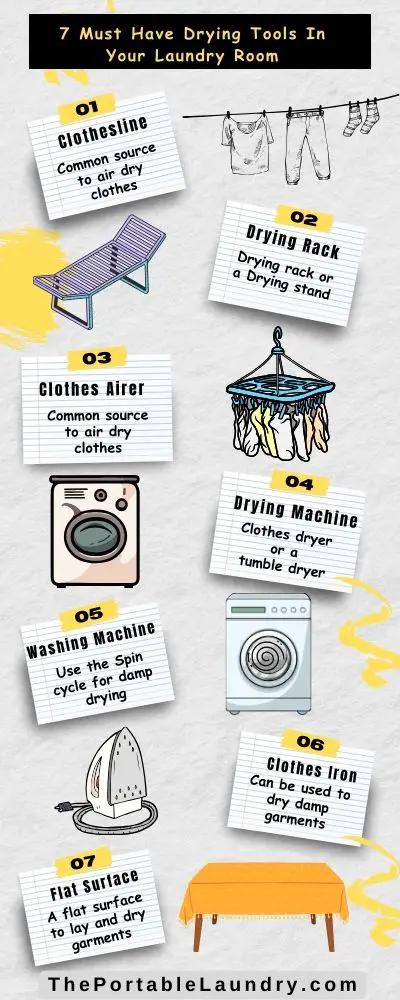
Must have drying tools in your laundry room
Let us discuss the basic laundry drying tools or the methods below.
Clothesline
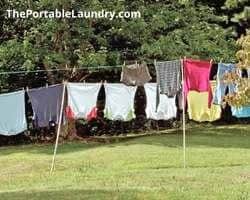
One of the most traditional ways to dry your fabrics is by simply hanging them over the clothesline.
The ropes used in clotheslines can be made from a variety of materials (nylon ropes are the most common).
These clotheslines are mounted using multiple ropes, one beside the other or in a straight line depending on the availability of space.
Using a clothesline is fairly simple; just hang your clothes on the clothesline and secure them with clips to prevent them from flying in the strong breeze.
The ropes can be tied in any corner of your laundry room or other spaces such as balconies, gardens, or terraces.
A clothesline rope can be tied to the poles on either side or simply knotted over the hooks along the wall.
Another type of clothesline that is commonly used is the wall-mounted style, which is made of stainless steel pipe and two frames.
The frames are mounted using screws or nuts over the walls at both ends and are installed on balconies or two walls in your laundry room that face each other closely.
Some people use pulleys and fix the ropes on either side as a clothesline. To keep the ropes sturdy and straight, you can use a clothesline tightener and fix them to the ropes close to the edges.
Pros:
- Eco-friendly; no energy consumption.
- Gentle drying, which prolongs fabric life.
- Sunlight can help disinfect and whiten clothes.
- Free to use; no operational cost.
Cons:
- Weather-dependent; ineffective during rain or extreme cold.
- Slower drying in humid conditions.
- Limited hanging space.
- May leave crease marks on clothes.
Drying Rack or Drying Stand
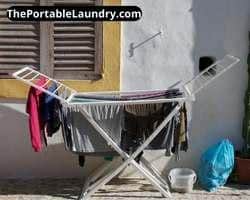
Clothes drying racks are the best tools to dry multiple garments in a small space.
These racks are portable and are designed to be foldable.
Being foldable it makes it easy to store them after every use.
Some drying racks are designed for placement based on available floor space, whereas some collapsible clothes drying racks can stand tall in a vertical position, especially in a narrow space.
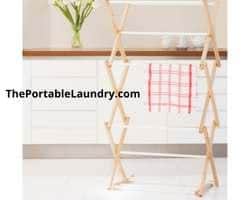
You can choose a stand as per the space available in your laundry room or the drying area.
To optimize the drying time, you can place them under a fan or below a portable fan.
Garments can be hung over the dedicated lines or you can simply lay them flat for some fabric types.
Due to all these added conveniences, drying racks have become an important tool for drying your laundry.
Pros:
- Suitable for indoor use in small spaces.
- Portable and collapsible for easy storage.
- Allows for efficient air circulation during drying.
- Can be used for delicate fabrics.
Cons:
- Slower drying compared to mechanical dryers.
- Takes up floor space when in use.
- Not suitable for large loads.
Clothes Airer
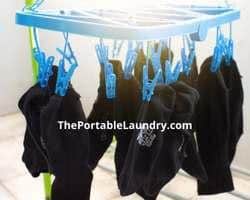
The clothes airer is similar to a drying rack.
To dry clothes, the airer can be hung from the ceiling of a laundry room or balcony, just like traditional drying racks.
If you run out of space in your household or the flooring, then you can use a clothes airer to dry your clothes.
Some clothes airers include clothespins or hanging clips to hold and secure the tiny garments.
Pros:
- Utilizes vertical space; great for apartments.
- Can be used indoors in laundry rooms or balconies.
- Can hold multiple garments at once.
- Suitable for small spaces.
Cons:
- Installation may require drilling.
- Limited drying capacity compared to larger options.
- Longer drying times due to limited air circulation.
Also Read: How to Install a Clothesline Tightener?
Clothes dryer
A clothes dryer is referred to as a “laundry drying machine” or simply a “dryer,” and they are the quickest tool for drying garments in a laundry room.
Clothes dryers are usually available as separate units altogether or as an all-in-one unit combined with the washing machine.
With that said, it’s always better if you do not use them as a plug-and-play tool, but instead, always use them wisely and only if needed.
For garments that are not suitable to be directly loaded into the dryers, you can place them in a laundry bag or simply use pillow covers or pillowcases.
You should always check the care label on your clothing to see if it can be dried in a washing machine or a dryer before doing so.
Pros:
- Fast and efficient drying.
- Suitable for all weather conditions.
- Requires less space compared to outdoor drying.
- Can accommodate larger loads.
Cons:
- Energy consumption and operational cost.
- May cause fabric damage with high heat settings.
- Not suitable for delicate fabrics.
- Initial purchase cost.
Washing Machine for the Spin cycle (damp drying)
Although the spin cycle of a washing machine won’t completely dry your clothes, it will get them damp and dry enough to air dry them quickly.
Using the spin cycle removes excess water from the clothing and further reduces the drying time of your garments.
Some fabrics aren’t suitable for this washing program, but most do. If your garments are not suitable for spin drying, you should try other drying methods.
Pros:
- Removes excess water, speeding up air drying.
- Preserves fabric quality by reducing exposure to heat.
- Suitable for most fabrics.
- Can be part of the washing machine cycle.
Cons:
- Doesn’t fully dry clothes; additional drying time needed.
- Not suitable for extremely delicate fabrics.
- May cause tangling of clothes.
Ironing damp garments
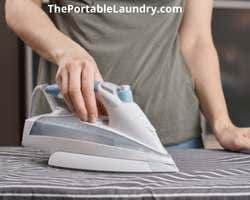
A clothes iron is another tool to dry your damp garments and, again, it should be used on damp dried garments only.
To add more safety, simply place a thin piece of cotton cloth over the damp, dried garment when you lay it flat on the ironing board.
Make sure to use low or moderate heat settings in such conditions.
This will help you to dry your damp garment in a quick time and without causing any damage to the fabric or to the iron.
Do not use them directly over fabrics that aren’t suitable for ironing or heat. Simply refer to their care label and then proceed.
Note: It’s important to remember that ironing is most effective when used in addition to other drying methods, not as the sole drying method.
Pros:
- Quick method for slightly damp garments.
- Adds a finishing touch and removes wrinkles.
- Suitable for single items or small loads.
- Requires minimal space.
Cons:
- Risk of damaging delicate fabrics.
- Time-consuming for larger loads.
- Requires an iron and ironing board.
- Not suitable for heavily wet clothes.
Lay Flat Drying
Laying flat, as the word suggests, simply means placing your garments on a flat and dry surface. It’s a simple technique for drying your clothes after washing them.
Make sure to spread your clothes evenly for optimum results.
Placing them in an uneven manner will lead to wet spots on the edges, which simply means incomplete drying.
Most items are placed on surfaces for drying under the sunlight or on surfaces with good ventilation.
This method works best for bulky or fluffy items such as carpets, mats, furry blankets or sheets, etc.
Pros:
- Suitable for bulky or delicate items.
- Preserves fabric quality and shape.
- Natural air circulation and sunlight.
- Minimal risk of fabric damage.
Cons:
- Slower drying; longer exposure to humidity.
- Requires ample flat surface.
- Not ideal for all fabric types.
- Requires outdoor space or well-ventilated area.
Table providing examples of when each drying method/tool is most suitable
| Drying Method/Tool | When It’s Most Suitable |
| Clothesline | – Sunny and dry weather, ideal for fresh air and sun drying. – Delicate fabrics that may be damaged by high heat from dryers. – When energy conservation and eco-friendliness are priorities. |
| Drying Rack | – Limited space in a small apartment or laundry room. – Delicate garments that require gentle drying. – When you want to avoid energy costs associated with dryers. |
| Clothes Airer | – Apartments with limited outdoor space or balconies. – Hanging small items or delicates that may not fit well in a dryer. – When you want to avoid using floor space for drying. |
| Clothes Dryer | – During cold or rainy seasons when outdoor drying is not feasible. – Large families or households with heavy laundry loads. – When you need clothes to dry quickly, such as before an event. |
| Spin Cycle | – After washing clothes to remove excess water before air drying. – For clothes that are slightly damp and need a quick final drying step. |
| Ironing Damp | – For single garments or small loads that need quick touch-ups. |
| Garments | – When you want to remove wrinkles and achieve a polished look. – Fabrics that can handle heat without damage. |
| Lay Flat Drying | – Bulky items like blankets, comforters, and rugs. – Items that are sensitive to high heat or intense mechanical drying. – When you have outdoor space with good ventilation and sunlight. |
Final Thoughts
Drying a wet or damp fabric in a timely manner is of utmost importance as it helps in preventing foul smells due to trapped moisture and color bleeding.
Just make use of suitable drying techniques depending on the availability of tools and space in your laundry room.
Lastly, do not use irons on wet fabrics to avoid any damage to the fabric. Also, before deciding how to dry your garments, be sure to check the care label.
You May Also Like
- 7 Must Have Washing Tools That Make Your Life Easier
- How to Calculate Power Consumption of Washing Machine?
- Should You Wash Spot Clean Only Fabrics Or Clothes? (Explained)
- What is a Portable Handy Bucket Washing Machine Device?
- What Is A Tide To Go Liquid Pen? & How to Use It?
- What is a FoldiMate in Laundry? (Benefits & Drawbacks)
- What is a Laundry Marker? (Explained)
- How To Replace Tub-To-Pump Hose In Washing Machine?
- Laundromats OR Home Laundry? (Which is Cheaper?)
- Five Stages Of Laundry Process (Explained)

